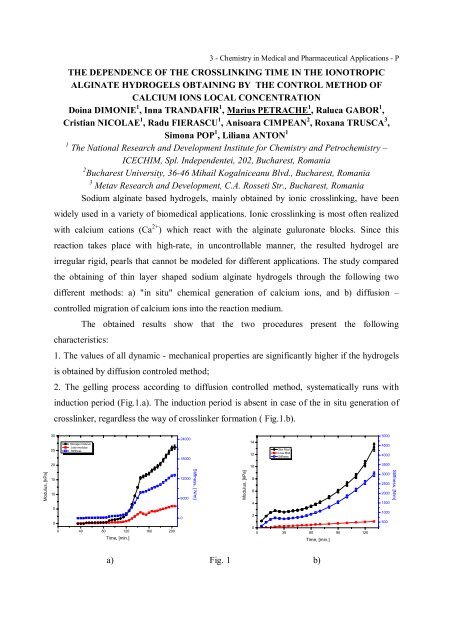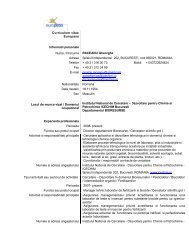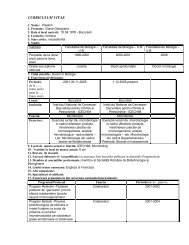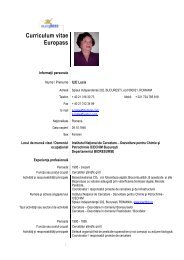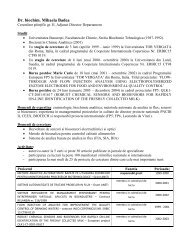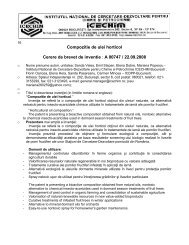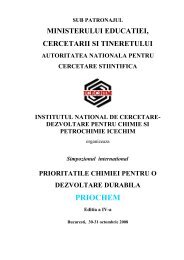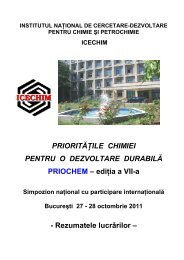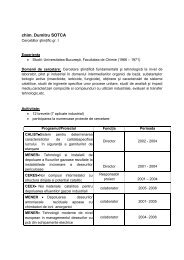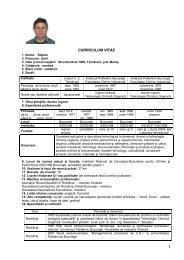INSTITUTUL NAÅ¢IONAL DE CERCETARE-DEZVOLTARE - ICECHIM
INSTITUTUL NAÅ¢IONAL DE CERCETARE-DEZVOLTARE - ICECHIM
INSTITUTUL NAÅ¢IONAL DE CERCETARE-DEZVOLTARE - ICECHIM
- No tags were found...
Create successful ePaper yourself
Turn your PDF publications into a flip-book with our unique Google optimized e-Paper software.
3 - Chemistry in Medical and Pharmaceutical Applications - PTHE <strong>DE</strong>PEN<strong>DE</strong>NCE OF THE CROSSLINKING TIME IN THE IONOTROPICALGINATE HYDROGELS OBTAINING BY THE CONTROL METHOD OFCALCIUM IONS LOCAL CONCENTRATIONDoina DIMONIE 1 , Inna TRANDAFIR 1 , Marius PETRACHE 1 , Raluca GABOR 1 ,Cristian NICOLAE 1 , Radu FIERASCU 1 , Anisoara CIMPEAN 2 , Roxana TRUSCA 3 ,Simona POP 1 , Liliana ANTON 11 The National Research and Development Institute for Chemistry and Petrochemistry –<strong>ICECHIM</strong>, Spl. Independentei, 202, Bucharest, Romania2 Bucharest University, 36-46 Mihail Kogalniceanu Blvd., Bucharest, Romania3 Metav Research and Development, C.A. Rosseti Str., Bucharest, RomaniaSodium alginate based hydrogels, mainly obtained by ionic crosslinking, have beenwidely used in a variety of biomedical applications. Ionic crosslinking is most often realizedwith calcium cations (Ca 2+ ) which react with the alginate guluronate blocks. Since thisreaction takes place with high-rate, in uncontrollable manner, the resulted hydrogel areirregular rigid, pearls that cannot be modeled for different applications. The study comparedthe obtaining of thin layer shaped sodium alginate hydrogels through the following twodifferent methods: a) "in situ" chemical generation of calcium ions, and b) diffusion –controlled migration of calcium ions into the reaction medium.characteristics:The obtained results show that the two procedures present the following1. The values of all dynamic - mechanical properties are significantly higher if the hydrogelsis obtained by diffusion controled method;2. The gelling process according to diffusion controlled method, systematically runs withinduction period (Fig.1.a). The induction period is absent in case of the in situ generation ofcrosslinker, regardless the way of crosslinker formation ( Fig.1.b).302520Storage modulusLoss modulusStiffness2400018000141210Stor.ModLoss.ModStiffness5000450040003500Modulus, [kPa]1510500 40 80 120 160 200Time, [min.]1200060000Stiffness, [ N/m]Modulus, [kPa]864200 30 60 90 120Time, [min.]30002500200015001000500Stiffness, [N/m]a) Fig. 1 b)


